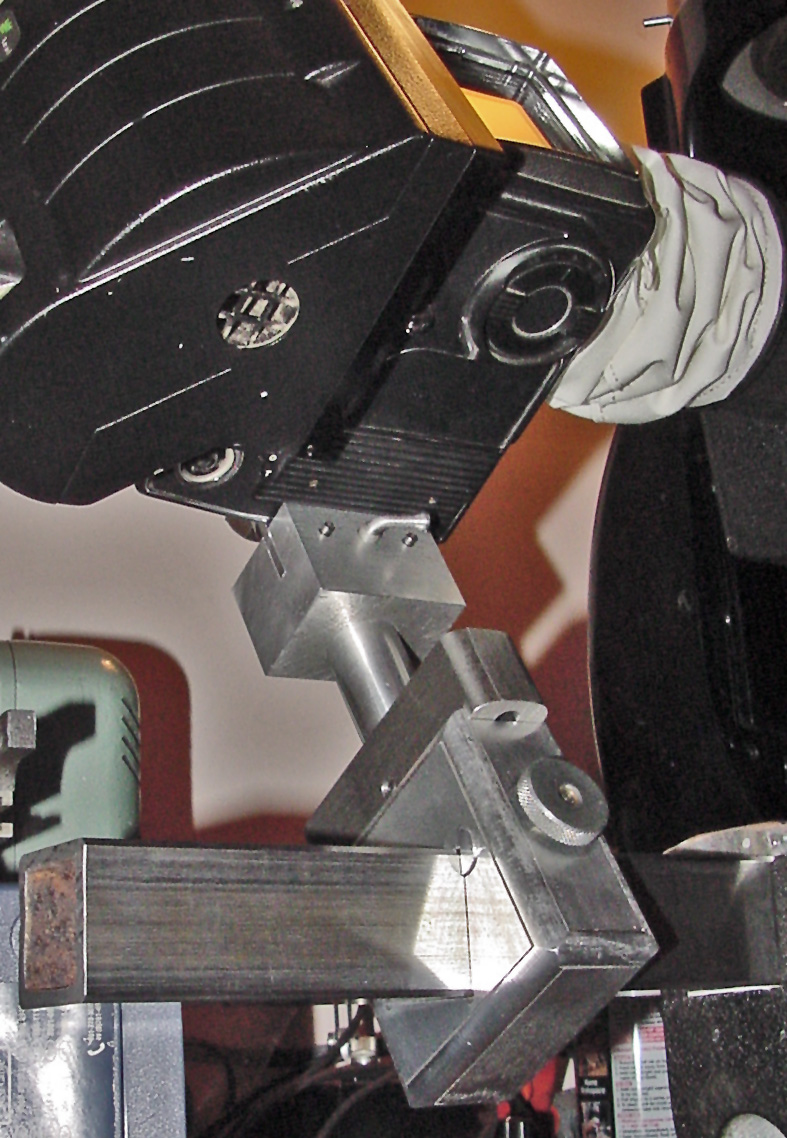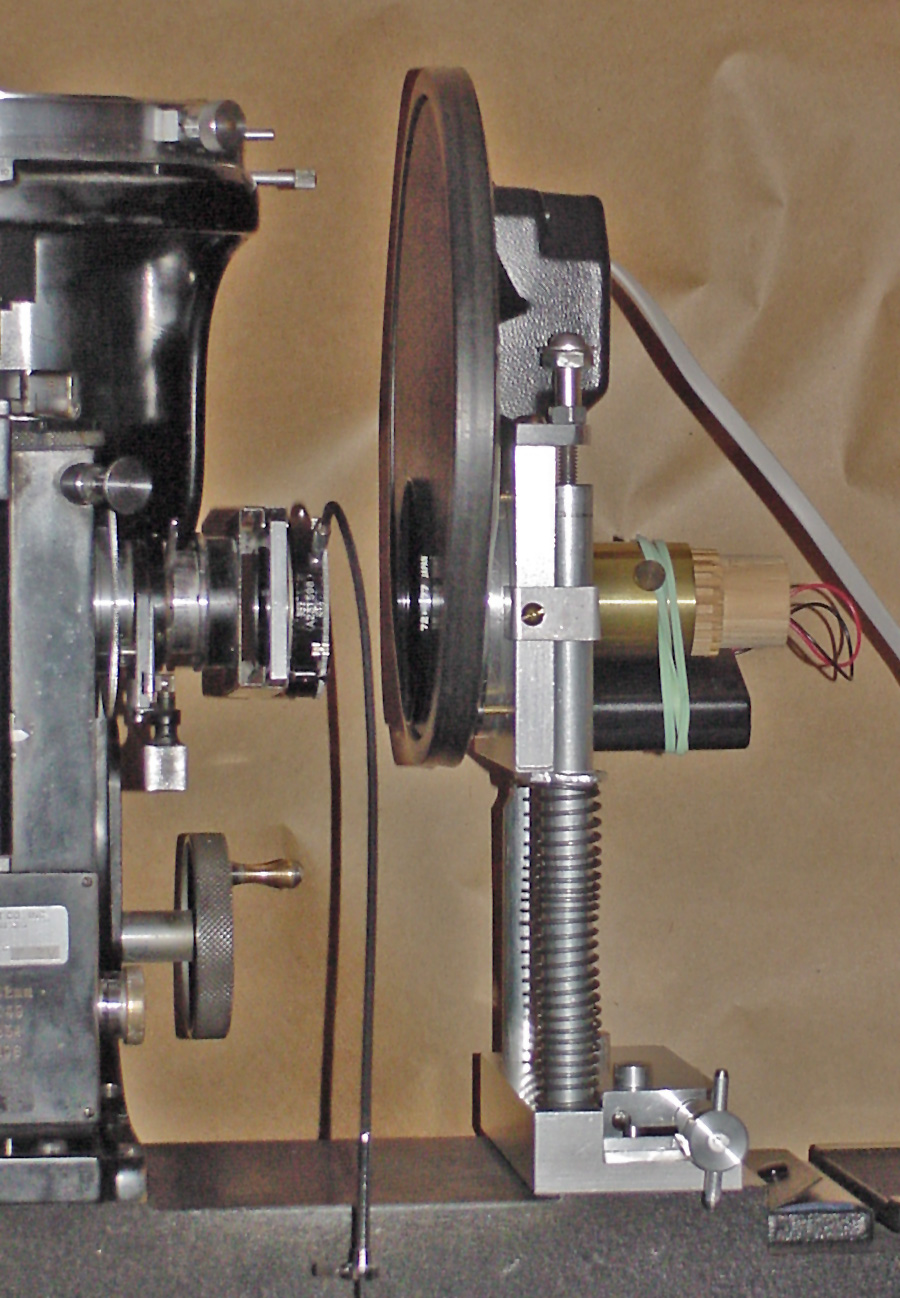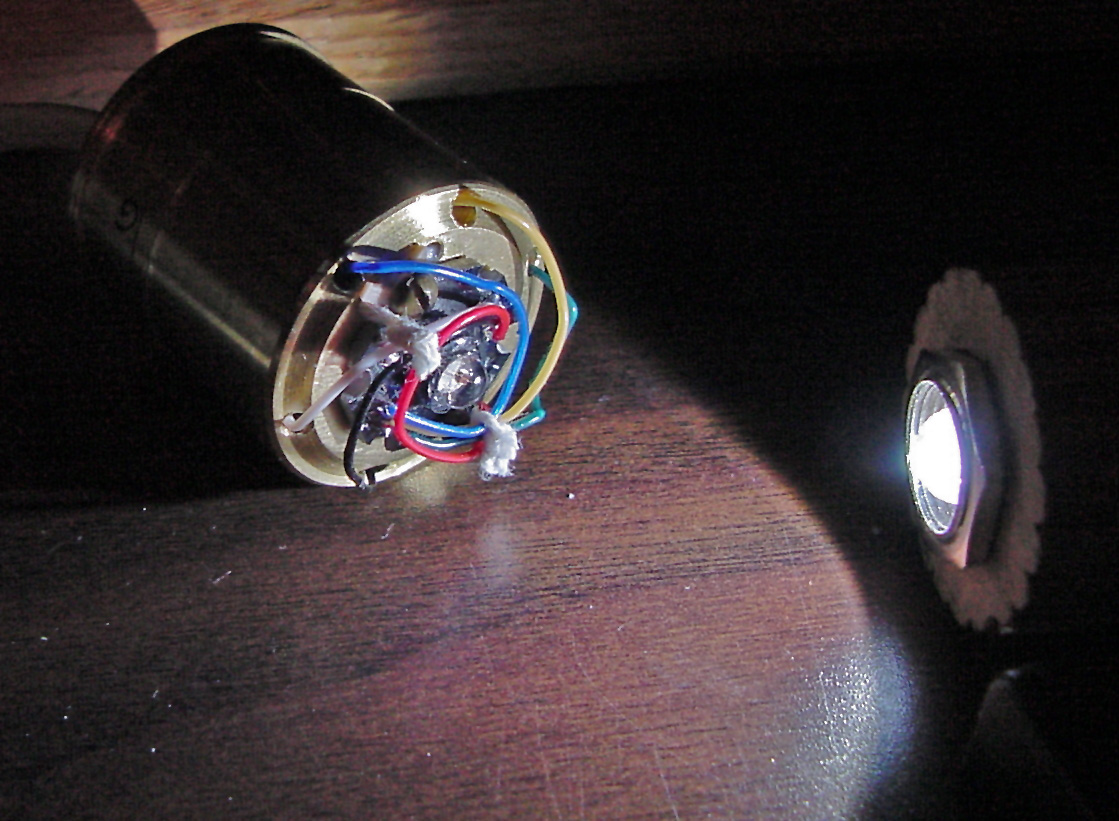adapted to a
Bausch & Lomb Research (I) metallograph
by George Langford
Previous progress: 9/11/2009; 7/29/2009; 7/26/2009; 1/21/2007
|
Rear
view of the Bausch & Lomb Research I metallograph, ca. 1953 - ex Penn State,
adapted for digital image recording with the Leaf Systems, Inc. DCB-II
camera back attached to a Hasselblad 500 EC/M body, with LED
illumination. The LED wasn't in the filter-wheel apparatus at left
when this picture was taken. The Leaf DCB-II is controlled
through a MacIntosh PowerMac 7100/80. Both the Mac and the DCB-II
are ca. 1995, recently obtained from a NYC professional
photographer who now does work involving motion, to which this digital
back is not suited. I got the Hasselblad body separately on eBay.

|
Originally, the filter wheel was operated through the
DCB-II's software, but now runs through manual control with a
latching-relay circuit that I built with reference here. Similarly, while the DCB-II software can control the shutter of the Hasselblad body, mirror bounce would be an horrific problem if I didn't instead use the Hasselblad's time exposure control in conjunction with the manually operated Compur shutter at left, which I mounted on a piece of two-inch square aluminum to fit the metallograph's filter holder. The DCB-II records color images by making three exposures in succession through first a red filter, then a green filter, and finally a blue one and then combining them into a sixteen-bit-per-pixel, 2048- by 2048-pixel HDR (high dynamic range - actually 14-bits) image. The DCB-II's software is used to normalize the exposure and thereby "develop" the image so that it can be saved in TIFF format. The sample photomicrographs at the bottom of this page were further processed with PhotoShop Elements and converted to 8 bits per color per pixel so they could be saved in the more presentable 24-bit JPEG format. Consequently, the "one-armed-paperhanger" metallographer first chooses, take picture, waits for the first (red) exposure to start in the DCB-II software, then trips the time exposure control on the Hasselblad, then trips the Compur shutter, then advances the filter wheel, then ends the time exposure, then recocks the Compur shutter, waits for the software to initiate the second (green) exposure, and so on. It takes about a minute to make one 25MB HDR-TIFF color image. When using the RGB LED instead, the filter wheel isn't needed, but one has to reposition the brass LED holder (seen below) so as to bring the appropriate color across the aperture diaphragm. With no other colors selected, there's no overlap of which to be wary. See the condenser setup. |
 |
 |
The
Hasselblad mount shown at left (back and front, repectively) has to
align the image to the 31mm by 31mm CCD sensor very acurately and
repeatably, and it has to be rigid. I shortened the originally 1000mm
bellows bar to 155mm to accommodate the longest bellows draw needed to cover the
sensor with a low magnification eyepiece. The 30-degree angle of
tilt brings the viewing angle for the Hasselblad's clear polycarbonate
"ground glass" into alignment with the Research I's eyepieces. I find
that a B&L 7X magnification loupe is needed for the critical
focusing of which both the DCB-II and Research I are capable. The bellows consists of an internal helical spring covered with black fabric surrounded by the white room darkening shade fabric that one can see at left. This arrangement allows me to slide the camera out of the way so as to access the projection eyepiece. The bellows is permanently attached to a Hasselblad body cap modified to hold the spring and other bellows parts. A quick twist of the wrist detaches the body cap and its bellows from the camera. |
 |
 |
The
filter wheel stand doesn't have to be as rigid as the camera's, but it
must be ridgily adjustable so as to hold its settings. The white
LED is shown in place at far left. The condensor lens has a 22mm
focal length and projects an enlarged image of the square LED die onto
the aperture diaphragm of the Kohler illuminator.
Consequently, less than one watt of LED power gives as much light as
the 100-watt incandescent lamp that originally came with this
metallograph. A mock-up of the condensor is shown below with a three-color LED.  The three-color LED can be used to execute the DCB-II's photography instead of using the filter wheel, but then the LED holder has to be first re-aligned and then rotated for each color's exposure. |
 |
 |
 |
 |
 |
Here
are better focused images of the three LED dies at far left and the
wiring of the three-color (one watt each) Luxeon LED at right,
illuminated by the flashlight bulb replacement white LED. I had to use
several switches in the RGB LED's controller (below) in order to run
each LED individually with Luxeon's 350mA current source or
alternatively through all three in series. This takes six control
wires. The higher power Luxeon RGB LED has its own aluminum
substrate, but I attached that with a mica insulator and silicone
thermal tansfer grease onto the heavy brass holder, which gets warm to
the touch. |
 |
 |
The
white LED's current source is built into the base of the
flashlight-bulb replacement, so all that's needed is a power source
(four AA batteries in series) and an on-off switch, here supplied with
the Radio Shack four-cell battery enclosure. At right is the controller
for the RGB LED, where the rotary switch selects red , green or blue
and the six-pole DPDT switch selects RGB or white. The eight AA
batteries in series provide a little over twelve volts, about what the
Luxeon 350mA current source needs to drive all three LED's in series. |
| The
Reichert Nomarski attachment shown below was expressly adapted by an
anonymous source to fit the Bausch & Lomb Research-I
metallograph. The Reichert objectives that came with it were made
for a tube length of 250mm. Assuming the the designer knew what
he was doing, one can calculate the tube length of the original Bausch
& Lomb Research-I's objectives from the difference between the 65mm
height of the present Nomarski attachment and the 250mm tube length for
which the Reichert objectives were designed - 185mm. As the
Bausch & Lomb objectives made for the Balphot-I metallograph and
for use with Bausch & Lomb's TriVert bright field/dark field
vertical illuminator have a tube length of 215mm, that leaves vertical
room of 30mm for other manufacturers' Nomarski/DIC attachments when
used on the Research-I metallograph with the 215mm Bausch & Lomb
objectives which are commonly available on eBay. About that, more, later. |
 |
 Photomicrograph
of a 0.5% carbon steel in the heat-affected portion of a weld.
The objective is a 40X Reichert at 250mm tube length. The
eyepiece was a Zeiss 4.0X Projektiv, and the bellows extension was
53mm. The Reichert Nomarski attachment uses the polarized light
from the Foster prism of the Research I. The DIC element is moved
across the field of view by the lever at left in order to affect the
order of the interference pattern, and the wedge is moved up and down
by the knob at right to affect the degree of offset between the double
images produced by the DIC element. The magnification of the
color image is about 700X as viewed here. Photomicrograph
of a 0.5% carbon steel in the heat-affected portion of a weld.
The objective is a 40X Reichert at 250mm tube length. The
eyepiece was a Zeiss 4.0X Projektiv, and the bellows extension was
53mm. The Reichert Nomarski attachment uses the polarized light
from the Foster prism of the Research I. The DIC element is moved
across the field of view by the lever at left in order to affect the
order of the interference pattern, and the wedge is moved up and down
by the knob at right to affect the degree of offset between the double
images produced by the DIC element. The magnification of the
color image is about 700X as viewed here.More shown below. |
| Cast iron - 40X/250mm
T.L. Reichert objective; Zeiss 4.0X Projektiv eyepiece; 53mm bellows
draw. Reichert Nomarski DIC attachment on Bausch & Lomb
Research-I metallograph. Ca. 700X. |
Ferrite - 40X/250mm T.L. Reichert objective; Zeiss 4.0X Projektiv eyepiece; 53mm bellows draw. Reichert Nomarski DIC attachment on Bausch & Lomb Research-I metallograph. Ca. 700X. |
 |
 |